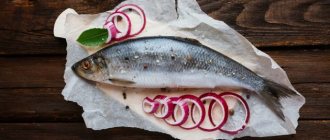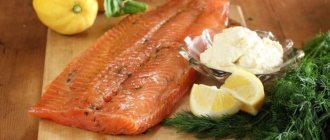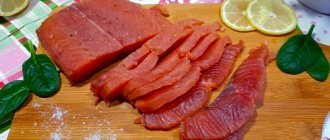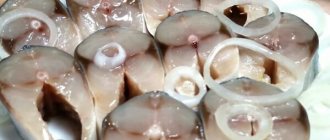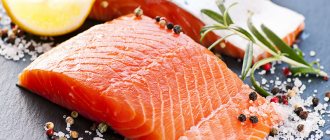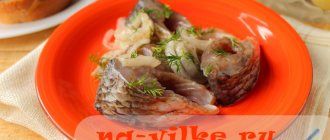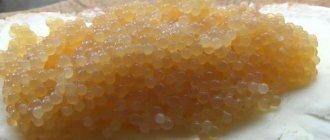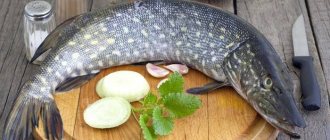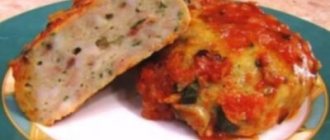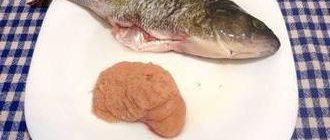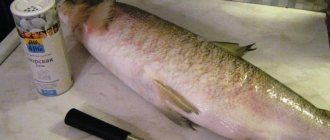What is usually done with pike caviar?
The usual method of preparing pike caviar is salting or pasteurization. Salting is a very simple and affordable way of processing. To do this, just add salt to the caviar in a proportion of 2-3% of the amount of caviar, and let it sit for a couple of days. If you serve this product in a beautiful special bowl, add chopped onion and season it all with sour cream, then pike caviar will be an excellent appetizer at any feast.
Pike caviar casserole
If your catch was rich in pike, but you don’t know how to cook pike caviar other than salting it, prepare this simple but very tasty casserole. Take:
- fresh pike caviar - ½ kilogram,
- white bread - 200 grams,
- milk - ½ cup,
- onions - 2 pieces,
- sunflower or olive oil - 2 tablespoons,
- tomato paste - 1 tablespoon,
- salt, black pepper, nutmeg - to your taste,
- breadcrumbs - 1 tablespoon.
How to extract caviar from pike?
The fish is first washed well and freed from entrails. The bags filled with caviar, called yastyki, are carefully removed. Before salting, caviar is freed from the eggs, cleaned of film, blood and anything that is not caviar. You can carry out the cleaning procedure using several simple procedures:
- The yastyki can be scrolled in a meat grinder. But this method has its pitfalls. The film from the yokes is sometimes simply wound around the screw of the meat grinder; it will have to be disassembled and cleaned. It may happen that the film is crushed into small pieces, which will subsequently need to be removed for a long time.
- Connoisseurs sometimes use a mixer to quickly extract caviar. With this method, the film remains on the blade of the device, from where it cannot be removed.
- You can use a grater to extract eggs. The yastiki are rubbed on the largest holes of the grater, the films themselves remain in the hands and are thrown away.
- Rubbing the bags through a sieve gives the same result.
- There is another fairly simple but effective method. For it you need to prepare a fork, a colander and a lot of water. All available bags are placed in a basin, the volume of which is three times larger than the caviar placed in it. Then the basin is filled with boiling water. Gently stir the contents of the bowl with a fork for about 5 minutes. During this time, the films will dissolve and rise to the top. Remove any floating films with a spoon and drain the boiling water. The bowl with caviar is then filled with cold water, mixed and the water is drained again. This manipulation is repeated many times, sometimes up to 15, until all the films are washed and the water becomes clearer.
Then, after cleaning the caviar, it should be passed through cheesecloth. The gauze is laid in several layers and placed at the bottom of a colander. The piece of gauze should be large enough to accommodate the entire caviar. Next, pour in water with caviar and wait until the water flows out. The gauze with caviar is wrapped and carefully squeezed out. After this, the caviar is ready for further processing. It is very important that there are no side inclusions left in it.
How to clean caviar from film
There are people who combine the process of cleaning caviar from the film with primary disinfection with boiling water and the beginning of salting. I never liked this option. Yes, and I’m used to salting fresh product, immediately on the shore after being caught. But the cases are different, so I will describe two ways to get rid of the jastyk - camping and home.
Field process of cleaning caviar from film
A shoot is cut out from the nearest non-coniferous tree, from which three branches have grown from the internode. We get rid of the bark with a sharp knife. I don't have an example at hand, but I think you understand what I mean. The result is a sling on a stick.
The further process is simple. Having placed the bags of caviar in a convenient container and holding the made slingshot between your palms, we begin movements reminiscent of making fire using the friction method.
You shouldn’t be too zealous so that the caviar doesn’t end up overboard, but don’t do it gently either. As a result, all the caviar film remains on the slingshot, and the pike eggs themselves are separate from each other.
Cleaning pike caviar at home
If you didn’t take care of making the device described above while fishing, then at home, when there is a large volume of caviar, I use a coarse grater.
When there is only a small amount of product, roughly speaking for a liter jar, then use a colander or an ordinary fork.
I definitely reject the recommendations to pass caviar through a manual meat grinder and do not advise you to do so. Transferring a valuable product because of your laziness and desire to quickly salt it is better not to undertake it at all.
When, at the age of 80, I marry a young woman of about 40 for the second time, I will definitely make sure that she does not do this.
Even before the completion of the construction of the BoGES, you didn’t have to travel far to get pike; you used a specially made sieve to clean the caviar. Just right for large volumes. But not so long ago I gave it away as unnecessary.
Recipes for preparing pike caviar at home
- Salting method. Remove caviar from films and other inclusions and add salt to it. You should take 10 g of salt per glass of product. Then the salted product is transferred to a separate container and a small amount of vegetable oil is added. The container is placed in a cool place overnight, but not in a refrigerator. The product can be consumed in the morning.
- A quick way to pickle sandwiches. The caviar bags are washed. Fill the pan with water with added salt and heat it to boiling water. Then the container is removed from the heat and the bags are lowered into it. The contents are stirred without interruption. The films will dissolve after a certain period of time, the caviar is passed through a sieve and placed in a jar into which a small amount of vegetable oil is poured. Do not seal the jar, the caviar may “suffocate”. The product processed in this way is stored in the refrigerator.
- Drying. The dried product is a good addition to beer. The caviar in the yastyk is rolled in salt, placed in an enamel bowl, and a weight is placed on top. The vessel with caviar is placed in the refrigerator compartment. After 3-5 days, the bags are washed and then dried for about 5-7 days. Dried caviar is ready.
- Fried caviar. The yastyki are washed, rolled in salted flour and fried in a frying pan with sunflower oil. Fry the bag on each side for about 5 minutes. The dish turns out appetizing and very tasty.
What to cook from pike caviar - recipes
Pike caviar has amazing nutritional characteristics and unique beneficial qualities. It goes on sale in canned form, so it can be safely used as a filling for shortcrust pastry baskets, sandwiches, canapés, as a separate snack, and can also be added to sauce, pate and fish mousses.
When consuming the product, you need to remember that it should not be consumed by people with individual intolerances, as well as children under 3 years of age, due to the presence of collagen in it, which can cause allergies. When properly processed, pike caviar turns out to be quite appetizing and delicate in taste.
Casserole
- fresh caviar - 500 g,
- bread - 200 g,
- milk - 300 ml,
- shallot,
- concentrated tomato paste - 1 tbsp.,
- salt,
- ground allspice,
- spices for fish,
- breadcrumbs for breading.
Processes:
- Free the eggs from veins and mucus.
- Rinse with clean water and transfer to a large bowl.
- Soak the pieces of bread with milk.
- Lightly sauté the onion in vegetable oil, grind through a meat grinder along with the bread, and add to the caviar.
- Season with spices, add tomato paste.
- Mix all ingredients.
- Preheat the oven to 190 degrees.
- Grease a heat-resistant dish with vegetable oil and sprinkle with breadcrumbs.
- Distribute the prepared mixture evenly around the perimeter of the mold, level with a spatula and place in the oven for 30 minutes.
- Check the readiness of the casserole using a wooden stick or match.
- Serve with stewed vegetables and herbs.
Cutlets
- Pike up to 2 kg,
- 2 eggs,
- 1 -2 onions,
- 2 tbsp., l. semolina,
- vegetable oil,
- olives,
- salt, pepper, herbs as desired.
Preparation:
- Cut the carcass into fillets.
- Grind the caviar (without roe) and fish meat in a blender.
- Add finely chopped onion, semolina, herbs, salt, and ground pepper to the prepared minced meat.
- Prepare 2 bowls. Beat the eggs in one and add breadcrumbs to the other.
- Form the minced meat into round balls with an olive inside.
- Dip the cutlet first into the egg, then into the breadcrumbs.
- Fry in well-heated oil until cooked and golden brown.
- Serve with lemon and vegetable garnish.
Pancakes
- Pike caviar - 400 gr.,
- Sour cream 20% fat - 2 tbsp.,
- Chicken egg,
- Premium flour - 1 cup,
- Spices for fish, salt to taste,
- Refined oil.
Step by step guide:
- Transfer the caviar to a bowl.
- Remove tight joints.
- Grate the onion on a fine grater.
- Add sour cream, flour, salt, spices.
- Beat in the egg.
- Mix all ingredients, removing lumps.
- The degree of density of the dough for caviar pancakes should resemble thick sour cream.
- Place portions with a spoon into a hot frying pan with sunflower oil, frying for 2 minutes on each side.
- Serve hot, with sauce or ketchup.
Sandwiches with caviar
The classic version of caviar sandwiches consists of only 3 ingredients: bread, butter and caviar itself. With a little imagination, you can come up with countless treats that will add variety to the holiday table.
“Royal canapes”:
- French baguette;
- canned caviar;
- cream cheese;
- cilantro;
- lemon juice;
- olives or olives, preferably pitted;
- Using a shot glass, cut out a round base from the bread and lightly fry it in a dry frying pan.
- In a blender bowl, combine cheese and finely chopped herbs, adding a pinch of salt.
- Sprinkle the crouton with lemon juice.
- Using a pastry bag and a nozzle, pipe the “green cream” onto the crouton, make a depression, and place the caviar quenelles on top.
- Additionally decorate with herbs and olive slices.
- The dish can be served to the table.
Pike caviar soup
- Pike caviar – 500 gr.
- Potatoes – 4 pcs.
- Onion – 1 pc.
- Carrots – 1 pc.
- Flour – 200 gr.
- Greens, salt, pepper, bay leaf.
Cooking steps:
- Wash fish products, separate from films, and place in boiling water.
- Place the potatoes cut into wedges.
- Cook for 20 minutes.
- Fry chopped onions and carrots in vegetable oil.
- While stirring the boiling broth, add bay leaf, salt, pepper, vegetables and flour.
- Cook over low heat for 5 minutes.
- Decorate the finished dish with herbs.
Tartar sauce
Ingredients:
- pike caviar – 100 gr.,
- 1 tsp chopped onions,
- olive oil - 70g,
- 0.5 tsp wine vinegar (you can use balsamic),
- sea salt.
Preparation:
- Place the caviar in a bowl convenient for whipping.
- Add onion.
- Whisk, adding oil, until a thick mass forms.
- Lightly salt and add a couple of drops of vinegar.
- Continue beating until the mixture doubles in volume.
- Serve chilled.
Salad with pike caviar
For 8 servings you will need:
- Ham - 200 g,
- Crab meat – 100 g,
- Boiled chicken breast - 200 g,
- Pickled cucumber - 3 pcs.,
- Onions – 1 pc.,
- Pike caviar - 1/2 jar.
- Tomato - 2 pcs.,
- Mayonnaise - 200 g,
- Dill and parsley, lettuce leaves (for decoration),
- Boiled egg - 2 pcs.
Preparation:
- Cut ham, cucumbers, chicken and crab meat into strips.
- Add salt to taste.
- Add caviar, mayonnaise and mix everything.
- For dressing it is better to use homemade mayonnaise.
- Add pickled onions. To do this, cut the onion into half rings, place in a deep plate, add 2 tbsp. l. vinegar and pour boiling water. After 10 minutes, drain the water.
- Grate the boiled egg and place on top of the salad.
- Decorate the floor with tomato slices and herbs.
- Serve on clean lettuce leaves.
Salting at home
- 0.5 kg pike caviar,
- 3 tbsp. salt,
- 120 ml vegetable oil.
Preparation:
- Clean and rinse the caviar well.
- Place in a saucepan and sprinkle with salt.
- Beat the contents with a fork until white foam appears.
- Pour boiling water over and drain the liquid.
- Add salt and pour out some of the oil, mix everything well, leave in the refrigerator.
- Prepare jars for storage. To do this, it is better to take small containers, up to 200 ml.
- Before use, the container (along with lids) must be sterilized (the housewife chooses the methods independently).
- Scatter the caviar into jars.
- Cover the top with a 1 cm layer of sunflower oil, close and place in the refrigerator for 5 days.
Boiled, fried, stewed pike caviar has a number of positive characteristics that affect human health. It contains a sufficient amount of iodine, which is beneficial for the thyroid gland.
Let's celebrate! Eating such a product optimizes metabolic processes in the body, prevents the appearance of excess weight, and the unsaturated omega-3 fatty acid helps rid the body of excess cholesterol, cleanse blood vessels and improve heart function.
Useful properties of caviar
- Caviar is a product that is very useful for women. Women persistently struggle with excess weight throughout their lives, undertaking all kinds of restrictions and diets. This causes the body to lack many nutrients. Pike caviar, being a low-calorie product, will enrich the body with useful substances and will not increase weight during a diet.
- Pike caviar contains omega 3 acid. It has the ability to block the development of cancer cells, so caviar is a good preventative against cancer. In addition, omega 3 is included in many cosmetic creams that are recommended against skin aging and for its rejuvenation.
- Like any other, pike caviar is rich in iodine. It is necessary for the normal functioning of the thyroid gland. Caviar is a few of the foods that can bring iodine into our body.
- Another component contained in pike caviar is vitamin A. It helps maintain human immunity at a high level. In addition, vitamin A is good for the eyes.
- Pike caviar, due to the fact that it contains vitamin E, helps remove toxins from the body at the cellular level.
- The human body can obtain vitamin D only through sunlight or fish products. Caviar is rich in this vitamin, which strengthens bones and skin cells. Since childhood, we remember the taste of fish oil, which saturated the body with vitamin D. It can be replaced with pike caviar, even for a small child.
- The benefits of pike caviar are undeniable for those people who suffer from low hemoglobin. It improves blood quality.
Pickling pike caviar - a simple homemade recipe
If you do not have experience in salting caviar, use the simplest recipe. I strongly advise you to maintain the proportions correctly, otherwise the first experience may be unsuccessful.
Required:
- Caviar – 200 gr.
- Water – 2 liters (for rinsing).
- Salt - a large spoon (for rinsing).
- Salt for pickling - to taste.
- Sunflower oil – 2 large spoons.
- Pepper - a pinch.
How to pickle:
- First, you need to properly extract the caviar. When cutting fish, do not damage the egg sacs - ovaries. Carefully remove them and place them in a bowl. Carefully peel off the film. Ripe grains will easily separate from the film, although the process is quite labor-intensive and responsible.
- Rinse the product thoroughly to ensure no traces of films or other debris remain.
- Make a saline solution by dissolving salt in cold water (see recipe for proportions). For the specified amount of caviar we will need only 600 ml. brine. Measure out the required amount.
- Place on the stove and bring to a boil. Pour boiling brine over the caviar and leave for 5 minutes. Stir, remove all excess.
- Carefully drain the liquid, add a new portion of brine (600 ml), but this time warm.
- Leave for 20 minutes, then drain. Place the cleaned caviar in a colander. When most of the liquid has drained, transfer the contents to cheesecloth.
- Hang the gauze bag, leave it for half an hour, let the liquid drain out completely.
- Place the strained mixture into a bowl. Season with salt and pepper. Pour in the oil.
- Next, you need to carefully mix the product with a fork. This procedure is long, up to 15-20 minutes. Stir until the salt is completely dissolved. You'll know it's time to finish if white foam appears. The eggs will swell and change color slightly.
You might be interested to know: How to make caviar from semolina and herring.
How pink salmon caviar .
Pike cutlets.
